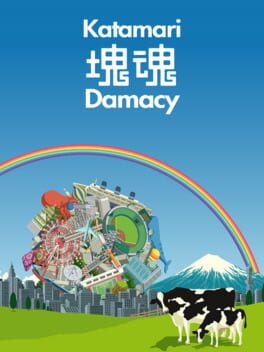One of the purest expressions of the childlike understanding of Play imaginable. Picture it: a painstakingly constructed diorama, each piece crude and small on its own, but weaving together to create little places, little stories, some sad, some thoughtful, some funny, all very very silly and creative, that in turn each weave together to a larger picture, a larger statement of the world and the vision it constructed it.
And then you come in with a wrecking ball, yelling "NEEEOORRRMMMM" and destroy it all.
Katamari Damacy captures Play how I remember it, silly, crude, anarchic, bursting with imagination and reflective of the world around me whilst having a callous disregard for permanence, consequences, and sense, with a voice from on high always on the edge of hearing, waiting to call an end to playtime.
Keita Takahashi's directorial work tends to lean more towards the idea of games as toys rather than a more modern conception of them, utilizing family-friendly graphics and very simple mechanics with de-emphasized win and lose states to make games that emphasize play for the sake of play, without drivers such as plot, mastery, or levelling up. However, Katamari Damacy raises itself above Noby Noby Boy and Wattam because of the constraints on that play it offers, the timelimits and the extra modes about avoiding or collecting specific items, are frictional elements that contextualise the experience wonderfully, like a father figure setting arbitrary tasks or constraints that push back against the barriers of a child's imagination. As much as I would prefer to just roll a big ball around sucking things up, these elements provide a sprinkle of thematic salt on an experience it would otherwise be easy to breeze through without thinking about.
And then there's the final moments of the final level, which twice now have struck me as a strangely lonely, boring experience where all you have left to do is hoover up the last few things in a vast empty space, a chore that pulls back the curtain on the artifice and pointlessness of what you've been doing. Where the diorama pieces just look pieces, when the dolls just look like dolls, when your imagination bounces right off them. When it's not Fun anymore, what is it?
There's a lot of really good pieces out there discussing this game from a variety of angles, and I agree with a lot of them, particularly those looking at the depictions of father-son relationships in the King and the Prince, but they aren't why I love Katamari Damacy.
No, I love Katamari Damacy because it makes me feel like a kid again. For good and for ill.
And then you come in with a wrecking ball, yelling "NEEEOORRRMMMM" and destroy it all.
Katamari Damacy captures Play how I remember it, silly, crude, anarchic, bursting with imagination and reflective of the world around me whilst having a callous disregard for permanence, consequences, and sense, with a voice from on high always on the edge of hearing, waiting to call an end to playtime.
Keita Takahashi's directorial work tends to lean more towards the idea of games as toys rather than a more modern conception of them, utilizing family-friendly graphics and very simple mechanics with de-emphasized win and lose states to make games that emphasize play for the sake of play, without drivers such as plot, mastery, or levelling up. However, Katamari Damacy raises itself above Noby Noby Boy and Wattam because of the constraints on that play it offers, the timelimits and the extra modes about avoiding or collecting specific items, are frictional elements that contextualise the experience wonderfully, like a father figure setting arbitrary tasks or constraints that push back against the barriers of a child's imagination. As much as I would prefer to just roll a big ball around sucking things up, these elements provide a sprinkle of thematic salt on an experience it would otherwise be easy to breeze through without thinking about.
And then there's the final moments of the final level, which twice now have struck me as a strangely lonely, boring experience where all you have left to do is hoover up the last few things in a vast empty space, a chore that pulls back the curtain on the artifice and pointlessness of what you've been doing. Where the diorama pieces just look pieces, when the dolls just look like dolls, when your imagination bounces right off them. When it's not Fun anymore, what is it?
There's a lot of really good pieces out there discussing this game from a variety of angles, and I agree with a lot of them, particularly those looking at the depictions of father-son relationships in the King and the Prince, but they aren't why I love Katamari Damacy.
No, I love Katamari Damacy because it makes me feel like a kid again. For good and for ill.
